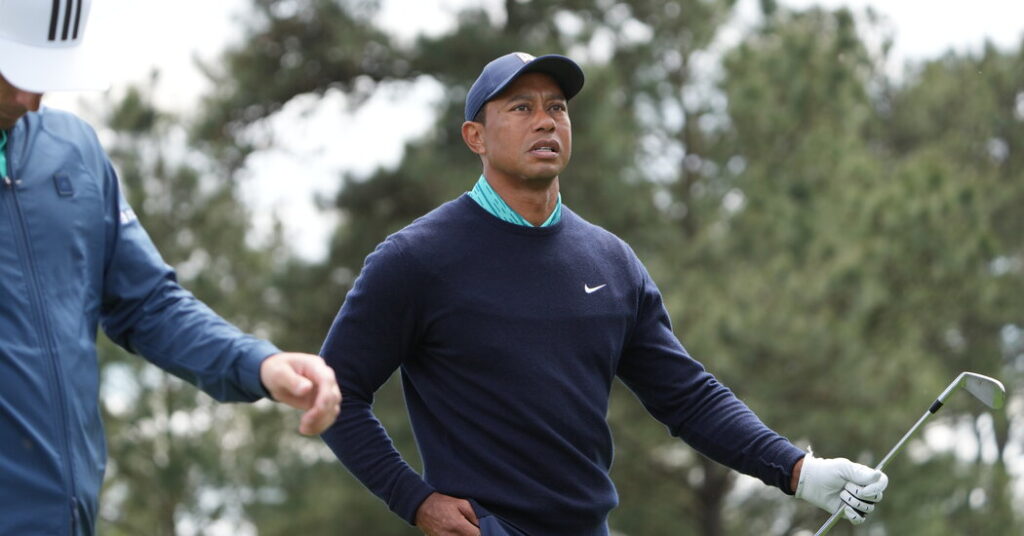AUGUSTA, Ga. — Tiger Woods stood in the glorious sunlight of a Georgia spring one afternoon this past week, a lingering dose of warmth before the frigid, hellish hours ahead.
“Lots of treatments, lots of ice, lots of ice baths, just basically freezing myself to death,” Woods said of his plans before his next tee shot at Augusta National Golf Club. “That’s just part of the deal.”
Rare is the athlete whose medical history has been more scrutinized and documented — by doctors, as well as by plenty of armchair experts in tournament galleries, living rooms and the news media — over the decades. But with Woods pursuing his sixth Masters Tournament title not even 14 months after a car wreck made a leg amputation a possibility, the 46-year-old golfer’s recuperation regimen has been more important than any read of any green.
The weekend, though, appears to be proving its limitations.
Woods shot a spectacular 71 on Thursday and a 74 on Friday. Taken together, the rounds, up and down as they were, were remarkable showings of the ferocity and grit that helped Woods to dominate his sport for years. But those pre-cut outings were expected to be the least taxing.
On Saturday, he posted a 78, the worst Masters round of his career. He went bogey or worse on seven holes, including the last three, and headed into Sunday’s final round at seven over par.
By sundown on Saturday, after a round dogged by wind and poor putting, it was nearly certain that the man who arrived at Augusta expecting to be both a contender on Sunday and a test case for the capabilities of a speedy rehabilitation would only be the latter.
To Woods, the concern throughout the week was never his golfing skill. Instead, he openly worried about the wear and tear on a body that enjoyed its easiest days long ago.
Asked Saturday how the physical challenge had evolved over the tournament, he replied: “It hasn’t changed. It’s been hard.”
He and his team have spent the hours between rounds trying to achieve dueling ambitions: reducing the swelling that comes with traipsing around the topographical nightmare that is Augusta, and keeping Woods’s surgically rebuilt limb “mobile and warmed up, activated and explosive for the next day,” as he put it at one of his meetings with reporters in Augusta.
“Most sports, if you’re not feeling very good, you got a teammate to pass it off to, and they can kind of shoulder the load, or in football, one day a week,” Woods said. “Here we’ve got four straight days, and there’s no one that’s going to shoulder the load besides me. I’ve got to figure out a way to do it.”
According to Woods, he has not taken a day off from his rehabilitation efforts since he emerged from the three months in bed that followed his one-car wreck near Los Angeles in February 2021. The crash left him with open fractures of the tibia and the fibula in his right leg, and it led surgeons to add rods, plates and screws to his leg.
The subsequent recovery has required trade-offs and gambles and, in something that is not new for Woods, unshakable confidence in his own talents, thrown off as they might be.
Some changes appear somewhat easier to accept than others, like new shoes to help with stability on the course. But experts have also developed protocols for before and after rounds — “after I go ahead and break it out there, they go ahead and repair it at night,” Woods said on Friday — that have dramatically expanded the timeline that comes with playing.
Those approaches, which may stretch for hours, have left Woods with less time for, say, hitting a thousand balls a day and refining, again, the nuances of his game.
“It gets agonizing and teasing because of simple things that I would normally just go do that would take now a couple hours here and a couple hours there to prep and then wind down,” he said. “So, activity time, to do what I want to do, it adds more time on both sides of it.”
The goal, he has said, was to build up the stamina that powered him and every other winner at Augusta, to give enough relief to make competitive golf more of a possibility than a pipe dream.
But the strategies can only dull, not extinguish, the pain, which Woods said is present “each and every day.”
He insists, though, that pain is not a problem. By his account, he did not have any unexpected physical setbacks in his first days back at Augusta. But he has acknowledged that everything weaves together.
“I expected to be sore and not feel my best, for sure,” Woods said on Friday. “It’s the combination. I can walk this golf course — I can put on tennis shoes and go for a walk, that’s not a problem. But going ballistically at shots and hitting shot shapes off of uneven lies, that puts a whole new challenge to it.”
He soon trudged off, presumably for another night of ice.

